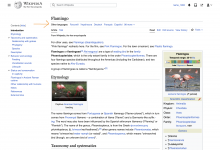Description
The previous version of the language switcher has two main elements:
- compact language links
- ULS menu
The compact language links allow people to easily switch languages (with a single click). The languages presented in the list are a best guess of which languages the person might want to switch to.
Goal
The purpose of this task is to explore how we might offer similar functionality in new Vector, and to consider in which cases we would want to show these additional links.
Examples:
| links next to button | language toolbar below page title | pinable language menu (prototype) |





